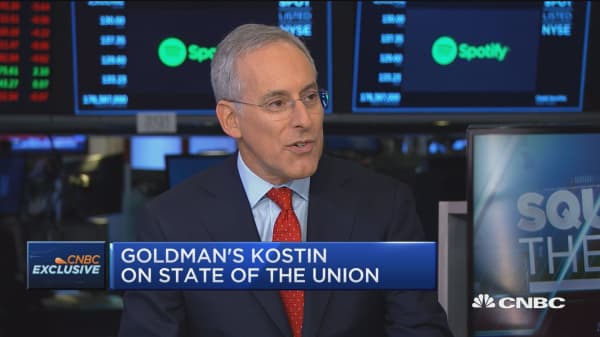A more accommodative Federal Reserve and the prospects for stable economic growth ahead have promoted Goldman Sachs to close a popular trade that it has backed for the past two years. Companies with low levels of debt compared with capital have been major outperformers since late 2016 just as the Fed was getting its rate-hiking cycle into high gear. As a group, they outperformed weak balance sheets by 25 percent points during the time, Goldman told clients in a note over the weekend. But with the central bank nearing the end of its policy tightening, Goldman thinks it’s time for investors to change strategy and shift to weak balance sheets vs. strong. “We have consistently advocated buying strong balance sheet stocks for the past two years, but the risk-reward has recently become less favorable,” wrote David Kostin, Goldman’s chief U.S. equity strategist. “The Fed’s dovish posture, the magnitude and duration of recent strong balance sheet outperformance, and relative valuations portend lower near-term prospective returns.” After hiking its benchmark interest rate four times in 2018 and nine times since it began normalizing policy in late-2015, the Fed now appears to be on hold at least through the early part of the year. Markets recoiled in the fourth quarter of 2018 after Fed Chairman Jerome Powell had indicated the Fed was a “long way” from a neutral rate. However, the Fed’s posture has changed recently amid concerns that growth could be slowing. Strong balance sheet stocks typically perform well when rates are rising and the economy is growing because those with more debt have trouble with financing costs. Corporate debt has been growing at a steady clip during the recovery and now exceeds $9 trillion. At the same time, Goldman’s market team sees the economy as being stronger than the Fed anticipates. The firm’s economists see just a 10 percent chance of a recession and think there’s a chance the Fed goes through with at least one rate hike. In addition to the changing climate, Kostin also said valuations for strong balance sheet companies are stretched. The group as measured by a basket of stocks is trading at 24 times forward earnings, against just 14 times for weak balance sheet companies. That kind of valuation was last seen during the tech bubble at the turn of the century. Goldman is not recommending that investors bail on low-leverage companies completely — Kostin said they are still worth some allocation as a “tail risk” hedge while earnings growth tails off and the companies continue to offer sustained growth ahead, albeit at a slower pace. Leading companies in the weak balance sheet basket include CBS, General Motors and Allergan. “The outlook for Fed policy, the pace of economic and earnings growth, and relative valuation are the key drivers of our view on strong vs. weak balance sheet stocks,” Kostin said. “Changes in these variables could cause us to reengage with strong balance sheets or pivot to recommending weak balance sheets instead.” The emergence of high-beta stocks and lower quality has been a boon so far for stock pickers. In January, a strong month for stocks, 49 percent of large-cap active managers beat their benchmarks, according to Bank of America Merrill Lynch. That’s ahead of the 43 percent that topped the market in 2018.Bubble valuations
Goldman Sachs is backing off the investing thesis it’s held for the past two years
Goldman Sachs’ chief US equity strategist: Recession fears have receded 4:35 PM ET Wed, 6 Feb 2019 | 06:45
The Fed, China and earnings are the biggest factors in the market, says expert 10:46 AM ET Wed, 6 Feb 2019 | 01:49






